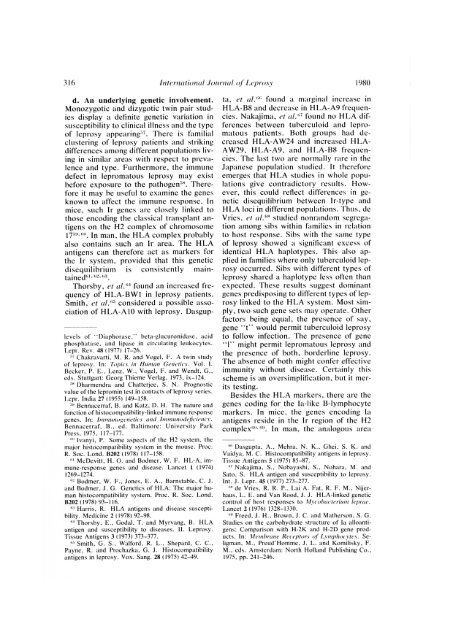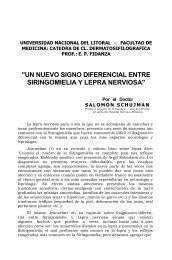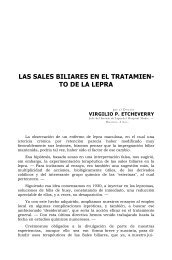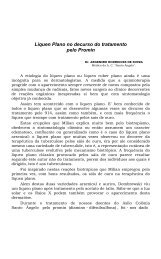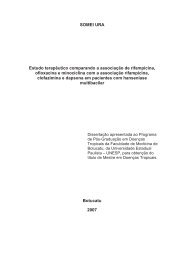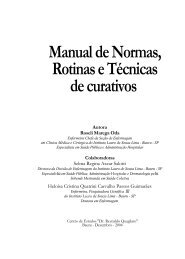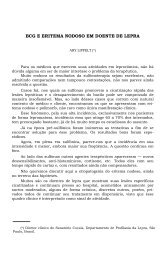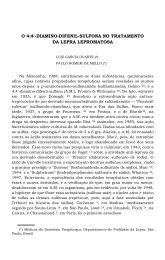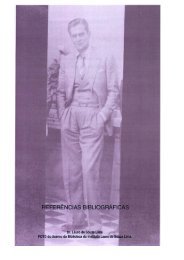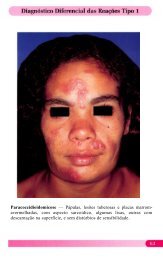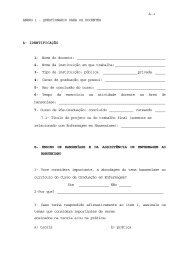EDITORIALS - Index of
EDITORIALS - Index of
EDITORIALS - Index of
Create successful ePaper yourself
Turn your PDF publications into a flip-book with our unique Google optimized e-Paper software.
316^ international .10arnal^Lepro.sy^ 1980<br />
(1. An underlying genetic involvement.<br />
Monozygotic and dizygotic twin pair studies<br />
display a definite genetic variation in<br />
susceptibility to clinical illness and the type<br />
<strong>of</strong> leprosy appearing''. There is familial<br />
clustering <strong>of</strong> leprosy patients and striking<br />
differences among different populations living<br />
in similar areas with respect to prevalence<br />
and type. Furthermore, the immune<br />
defect in lepromatous leprosy may exist<br />
before exposure to the pathogen'''. Therefore<br />
it may be useful to examine the genes<br />
known to affect the immune response. In<br />
mice, such Ir genes are closely linked to<br />
those encoding the classical transplant antigens<br />
on the I-12 complex <strong>of</strong> chromosome<br />
17 5"'". In man, the HLA complex probably<br />
also contains such an Ir area. The HLA<br />
antigens can therefore act as markers for<br />
the Ir system, provided that this genetic<br />
disequilibrium is consistently maintained"'•<br />
"2. ".<br />
Thorshy, et al."' found an increased frequency<br />
<strong>of</strong> HLA-BW1 in leprosy patients.<br />
Smith, et a/." 5 considered a possible association<br />
<strong>of</strong> HLA-A10 with leprosy. Dasgup-<br />
levels <strong>of</strong> "Diaphorase, — beta-glucuronidase, acid<br />
phosphatase, and lipase in circulating leukocytes.<br />
Lepr. Rev. 48 (1977) 17-26.<br />
Chakravarti, M. R. and Vogel, F. A twin study<br />
<strong>of</strong> leprosy. In: Topics . in Human Genetics. Vol. I.<br />
Becker, P. E., Lenz, W.. Vogel, F. and Wendt, G.,<br />
eds. Stuttgart: Georg Thieme Verlag, 1973, ix—I24.<br />
'" Dharmendra and Chatterjee, S. N. Prognostic<br />
value <strong>of</strong> the lepromin test in contacts <strong>of</strong> leprosy series.<br />
Lepr. India 27 11955) 149-158.<br />
'" I3ennacerraf, B. and Katz, I). H. The nature and<br />
function <strong>of</strong> histocompatihility-linked immune response<br />
genes. In: Immunogenetics and Immunodeficiency.<br />
Bennacerraf, B., ed. Baltimore: University Park<br />
Press, 1975. 117-177.<br />
"' Ivanyi, P. Some aspects <strong>of</strong> the H2 system, the<br />
major histocompatihility system in the mouse. Proc.<br />
R. Soc. Lond. 11202 (1978) 117-158.<br />
"' McDevitt, H. 0. and Bodmer, W. F. HL-A, immune-response<br />
genes and disease. Lancet 1 (1974)<br />
1269-1274.<br />
Bodmer, W. F., Jones, E. A., Barnstable, C. J.<br />
and Bodmer, J. G. Genetics <strong>of</strong> HLA: The major human<br />
histocompatihility system. Proc. R. Soc. Fond.<br />
8202 (1978) 93-116.<br />
"" Harris. R. I-ILA antigens and disease susceptibility.<br />
Medicine 2 (1978) 92-98.<br />
Thorsby, E., Godal, T. and Myrvang, B. HLA<br />
antigen and susceptibility to diseases. II. Leprosy.<br />
Tissue Antigens 3 (1973) 373-377.<br />
''' Smith, G. S., Walford, R. L., Shepard, C. C.,<br />
Payne, R. and Prochazka, G. J. Histocompatihility<br />
antigens in leprosy. Vox. Sang. 28 (1975) 42-49.<br />
ta, et al." found a marginal increase in<br />
HLA-138 and decrease in MLA-A9 frequencies.<br />
Nakajima, et al."' found no FILA differences<br />
between tuberculoid and lepromatous<br />
patients. Both groups had decreased<br />
HLA-AW24 and increased 1-ILA-<br />
AW29, HLA-A9, and HLA-138 frequencies.<br />
The last two are normally rare in the<br />
Japanese population studied. It therefore<br />
emerges that HLA studies in whole populations<br />
give contradictory results. However,<br />
this could reflect differences in genetic<br />
disequilibrium between Ir-type and<br />
HLA loci in different populations. Thus, de<br />
Vries, et al." studied nonrandom segregation<br />
among sibs within families in relation<br />
to host response. Sibs with the same type<br />
<strong>of</strong> leprosy showed a significant excess <strong>of</strong><br />
identical HLA haplotypes. This also applied<br />
in families where only tuberculoid leprosy<br />
occurred. Sibs with different types <strong>of</strong><br />
leprosy shared a haplotype less <strong>of</strong>ten than<br />
expected. These results suggest dominant<br />
genes predisposing to different types <strong>of</strong> leprosy<br />
linked to the HLA system. Most simply,<br />
two such gene sets may operate. Other<br />
factors being equal, the presence <strong>of</strong> say,<br />
gene "t — would permit tuberculoid leprosy<br />
to follow infection. The presence <strong>of</strong> gene<br />
"I — might permit lepromatous leprosy and<br />
the presence <strong>of</strong> both, borderline leprosy.<br />
The absence <strong>of</strong> both might confer effective<br />
immunity without disease. Certainly this<br />
scheme is an oversimplification, but it merits<br />
testing.<br />
Besides the HLA markers, there are the<br />
genes coding for the la-like 13-lymphocyte<br />
markers. In mice, the genes encoding Ia<br />
antigens reside in the Ir region <strong>of</strong> the H2<br />
complex"•". In man, the analogous area<br />
"' Dasgupta, A., Mehra, N. K.. Ghei, S. K. and<br />
Vaidya, NI. C. Histocompatihility antigens in leprosy.<br />
Tissue Antigens 5 (1975) 85-87.<br />
"' Nakajima, S., Nobayashi, S., Nohara, M. and<br />
Sato, S. HLA antigen and susceptibility to leprosy.<br />
Int. J. Lepr. 45 (1977) 273-277.<br />
de Vries, R. R. P., Lai A. Fat, R. F. M., Nijerhaus,<br />
L. E. and Van Rood. J. J. HLA-linked genetic<br />
control <strong>of</strong> host responses to Mycobacterium leprae.<br />
Lancet 2 (1976) 1328-1330.<br />
"" Freed, J. H., Brown, J. C. and Matherson. S. G.<br />
Studies on the carbohydrate structure <strong>of</strong> Ia alloantigens:<br />
Comparison with H-2K and H-2D gene products.<br />
In: Membrane Receptors Qf Lymphocytes. Seligman,<br />
NI., Preud'Homme, J. L. and Komilisky, F.<br />
NI., eds. Amsterdam: North Holland Publishing Co..<br />
1975, pp. 241-246.


